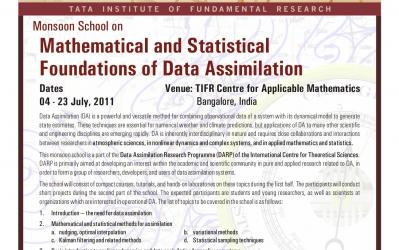Data assimilation (DA) is a powerful and versatile method for combining observational data of a system with its dynamical model to generate state estimates. These techniques are essential for numerical weather and climate predictions, but aplications of DA to many other scientific and engineering disciplines are emerging rapidly. DA is inherently interdisciplinary in nature and requires close collaborations and interactions between researchers inatmospheric sciences, in nonlinear dynamics and complex systems, and in applied mathematics and statistics.
The Data Assimilation Research Program (DARP) is primarily aimed at developing an interest within the academic and scientific community in pure and applied research related to DA, in order to form a group of researchers, developers, and users of data assimilation systems.
The initial set of activities will consist of a "Monsoon School on Mathematical and Statistical Foundations of Data Assimilation" along with an "International Conference on Data Assimilation" at the TIFR Centre for Applicable Mathematics and the Indian Institute of Science, Bangalore.
The school (04-12 July and 18-23 July) will consist of compact courses, tutorials, and hands-on laboratories on these topics during the first half. The participants will conduct short projects during the second part of the school. The expected participants are students and young researchers, as well as scientists at organizations which are interested in operational DA. The list of topics to be covered in the school is as follows.
1. Introduction -- the need for data assimilation
2. Mathematical and statistical methods for assimilation
a. nudging, optimal interpolation
b. variational methods
c. Kalman filtering and related methods
d. Statistical sampling techniques
3. Basic introduction to nonlinear dynamics and data assimilation for nonlinear systems
4. Applications to atmospheric, oceanic problems (including basic introduction to modelling)
The conference (13-15 July) will consist of invited and contributed talks during second week of the monsoon school. The list of invited speakers and abstract submission for contributed talks will be announced on the program webpage soon.
Note that there is no registration fee for the school or the conference. Selected school participants will get financial support for travel and local hospitality.
To apply (for participation in the school and/or the conference OR to make a presentation during the conference), please click on the "Apply" tab.
Application Deadline over on 30 April 2011. Selected participants have been contacted. (No emails will be sent to those who are not selected.)
 blr
blr  gmail
gmail com
com- Talks
- Other links


